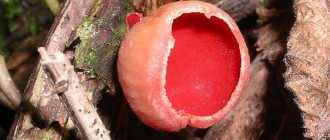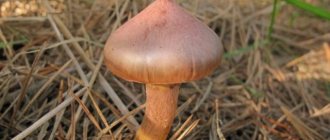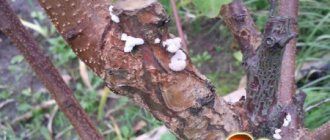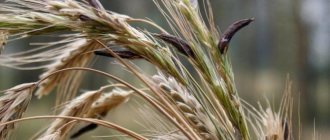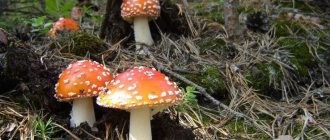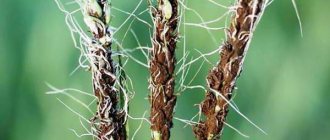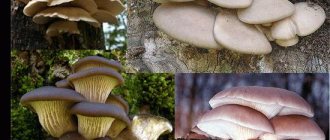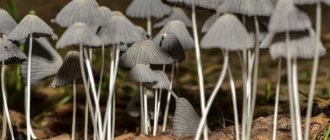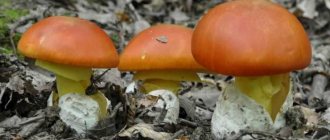Morphology
Signs of ergot infection are visually observed during the flowering phase.
The flowers of infected plants exude “honeydew,” a yellowish liquid. Dark fungal hyphae form on it, giving the ear a dark tint. After 14–21 days, soft whitish formations form on the affected plants. These are sclerotia. Over time, they grow, become harder and change color to black. Affected plants form small and sterile ears. (Stancheva Y., 2003) The causative agent is Claviceps purpurea, in the phase of vegetative reproduction - Sphaсelia segetum. (Dorofeeva L. L., 2007) Sclerotia are horn-shaped, black, hard formations that develop instead of grains in the ear. Rye usually produces from two to five horns, up to 45 mm long. On some cereal grasses, the length of the horns is no more than 3 mm. (Dobrozrakova, 1974) (Stancheva Y., 2003)
The stroma is purple and fleshy. They consist of a reddish head 3 to 4 mm in diameter and a stalk up to 5 cm long.
Perithecia are located inside the stroma head in a continuous layer near the surface. They have a pitcher shape. Perithecia stomata in the form of small papillae protrude from the surface of the head, giving it a rough appearance. One head contains 200-400 perithecia. In one perithecia, 32 asci are formed. One ascus contains 8 spores.
Asci are club-shaped or cylindrical.
Ascospores are unicellular, filamentous, colorless.
Conidiophores of the anamorphic stage are cylindrical, unicellular.
Conidia are elliptical, unicellular. (Peresypkin V.F., 1989)
Biology
The primary source of infection is sclerotia overwintered in the soil, as well as sclerotia sown in the field with seed material. Wild cereals play a major role in the spread of ergot. (Dobrozrakova, 1974) During grain harvesting, sclerotia from the ears fall off and remain on the soil surface or fall into the grain. When the temperature rises in spring to +10°C - +14°C, they germinate, forming stromas in which ascospores mature. Under the influence of osmotic pressure, mature spores are fired from the ascus and are carried by the wind across the field. When they fall on a plant flower, they germinate and form a mycelium that penetrates the ovary and destroys the contents of the cell. The mycelium forms a sticky liquid (“honeydew”) and a thick, colorless formation of conidiophores and conidia. The liquid attracts insects, which facilitate the movement of conidia to healthy plants. Other conidia are spread by moisture and wind. Once on rye flowers, conidia germinate and form a mycelium. It grows, hardens and by the time of harvest turns into sclerotia. In field conditions, sclerotia usually persist for a little more than a year. Sometimes there is a double wintering. When embedded in the soil to a depth of 6 to 8 cm, the sclerotia either do not germinate or the stromal heads do not reach the surface. Plants located on the outskirts of fields and along roadsides are most vulnerable to infection. In the center, ergot is most often absent. (Peresypkin V.F., 1989) The active development of the pathogen is favored by the combination of cloudy weather with low temperatures, precipitation and windy weather during the flowering period, growing cereals in the same field for two years in a row, the presence of cereals on the field and in close proximity to it herbs (Dorofeeva L.L., 2007) It is characteristic that an intense release of ascospores and rapid spread of infection are observed in sunny weather with high humidity. (Stancheva Y., 2003)
Purple ergot (Claviceps purpurea (Fries)
Botanical description and development cycle.
Purple ergot (Claviceps purpurea (Fries) Tulasne is a mushroom of the family Clavicepitaceae, class marsupial fungi - Ascomycetes, affecting mainly rye. During the flowering of rye, ascospores of the fungus land on the stigma of the pistil and germinate. The mycelium of the fungus penetrates the ovary and grows in it, at the ends of the hyphae a large number of colorless single-celled conidia are released, which are released on the ear in drops of sugary liquid (honeydew). The appearance of honeydew occurs 7-14 days after the flower is infected with fungal spores. This stage of ergot development is called sphacelial. Various insects feed on honeydew, and also, wind or raindrops transfer conidiospores to other flowers and infect them (secondary spontaneous infection of plants). After the cessation of conidial sporulation, the mycelial plexus of the fungus in the rye ovary becomes denser and turns into dark purple sclerotia, shaped like a horn. This is the resting form of the fungus. The horns are intensely grow until the grain ripens. The length of the horns is 10-60 mm, thickness up to 7 mm. The dry weight of one horn can reach 1.7 g. Horns, as a rule, are larger than rye grains, but lighter in specific gravity. Under natural conditions, ripe horns fall to the surface of the soil and overwinter there. In spring, the horns germinate, forming fruiting bodies - stromas, which have a reddish-violet color. The stroma consists of a stalk and a head. A large number of fruiting bodies (perithecia) develop in the heads in the form of oval cavities with narrow openings at the top. A mass of bags (asci) is formed in the perithecia. Each bursa contains 8 filamentous asco spores. Ripe spores are ejected from the perithecia opening and are carried by the wind. Once on the stigma of the pistil, they germinate, repeating the entire development cycle of the fungus.
Spreading.
Ergot has a cosmopolitan distribution. In the USSR it is found in all natural zones except deserts and tundra. The most favorable conditions for the development of ergot are the Baltic states, the western regions of Ukraine and Belarus, the Far East, i.e., areas with high relative air humidity (70% and above) and moderately warm weather during the flowering period of rye. The optimal temperature for the growth and development of the fungus is 24 C. Until the end of the 50s, the pharmaceutical industry's need for ergot was satisfied by collecting horns from rye when it was cultivated for grain.
Subsequently, the supply of wild ergot decreased sharply due to improvements in agricultural technology for cultivating grain crops, and thus its harvesting lost its practical significance. In this regard, ergot was introduced into the culture and is grown on winter rye on state farms of the Soyuzlekrasprom association.
Application in medicine.
Ergot horns currently serve as raw materials for the industrial production of alkaloids used in medicine. They are used in obstetrics and gynecology, for diseases of the circulatory system, some nervous disorders, in the form of drugs such as Bellataminal, Ergotal, Ergometrine, Caffetamine and others. In addition, the horns contain fatty oil, ergosterols, peptides, and amino acids.
Ergot strains.
Wild ergot is very heterogeneous in its alkaloid composition. VILR has created selection strains of ergot with a predominant content of one or another type of alkaloid. The selection of strains is carried out mainly on the basis of two economically valuable characteristics: the yield of horns and the content of alkaloids, taking into account their component composition. Using the rich gene pool of ergot and various selection methods, strains of the ergotamine, ergotoxic and ergometrine types were obtained. In terms of yield, content and purity of the spectrum of ergoalkaloids, domestic selection strains of ergot correspond to the level of the best foreign strains. Currently, two new breeding strains - ergotamine and ergotoxin - have been introduced into production and are cultivated on state farms of the Soyuzlekrasprom association. From the best super-elite cones selected for yield and alkaloid content, VILR carries out the primary multiplication of infectious material of selection strains. Annually updated super-elite infectious material of ergot in the form of pure cultures of the fungus is transferred along with a certificate of quality to specialized state farms.
To ensure the hereditary purity and authenticity of the strains, each farm cultivates ergot from only one of the selection strains: ergotamine or ergotoxin. In state farm laboratories, the resulting pure super-elite culture of the ergot fungus is propagated on nutrient media in mattress flasks. The grown elite infectious material infects all winter rye crops planned for commercial production of ergot horns.
Organization of work in state farm laboratories.
The cultivation of elite infectious ergot material is carried out under sterile conditions. To do this, it is necessary to have specially equipped premises consisting of several rooms: washing room; for preparing media and sowing fungi; autoclave; thermostatic; for storing flasks, materials and chemical reagents. The specific equipment of state farm laboratories is: a box with 2-4 bactericidal lamps BUF-18; 2-3 autoclaves AG-2, AG-3, GK-YuO-2; machine for making cotton plugs (TU 64-1-2309-72); continuous syringes; mattress flasks with a volume of 1.5-2.0 liters. at the rate of 25-30 pieces per 1 hectare of crop infection.
Preparation of nutrient media and cultivation of fungal culture.
To grow a saprophytic culture of ergot and obtain the largest number of conidiospores, which are the infectious material for infecting rye, sterilized rye grain or wort agar is used. Washed and dried rye grain must be of good quality: large and complete. The grain is packaged into mattress flasks in 200-250 g quantities, filling it with the same amount of water. The medium is sterilized for 30-35 minutes at 1.5 atm. To prepare a medium from wort agar, 1.5-1.6% agar-agar is added to unhopped beer wort and sterilized for 20 minutes at 1 atm.
Sterile media in flasks are inoculated with a pure super-elite culture of the ergot fungus, after which the flasks are transferred to a room with a temperature of about 20 C. At this temperature, the flasks with the ergot culture are kept for 30-45 days, then they are transferred to a cooler and dry shaded room with a positive temperature not below 4-5 C. Here the flasks should be stored before use for 2-3 months. Flasks overgrown with foreign microflora should be discarded.
Preparation of infectious fluid.
A spore suspension for ergot infection of rye can be prepared in laboratory or field conditions. For these purposes, tap, well or clean river water is used. There is no need to be afraid of short-term exposure to direct sunlight on the infectious liquid and the washed mycelium of the fungus. If the mushroom is grown on grain, the entire contents of the flask are transferred to a layer of gauze immersed in water. The grain is carefully washed from the fungal film, trying not to crush it. The mushroom grown on wort agar is removed from the surface of the agar using a metal scraper onto a nylon sieve. The film is rubbed through a sieve, immersing it partially in a bucket or tank of water.
A hectare norm of flasks is washed in 10-20 liters of water. The infectious liquid must be used on the day it is prepared. The infectious fluid is transported in milk cans. Water is delivered in clean tanks or barrels. The finished suspension of conidiospores is poured through a nylon sieve or double-layer gauze into the tanks of the machine, previously partially filled with water. After filling the tank with a suspension of spores, add water to the full volume.
The concentration of spores in the working infectious fluid is determined under a microscope using a Goryaev glass chamber device (model 851). The concentration of spores should be in the range of 5-10 thousand/mm3. The consumption rate of infectious fluid is 200 l/ha.
Features of growing rye with ergot.
Since the host plant for the parasitic ergot culture is rye, it can be grown in those regions where winter rye overwinters well, forms a uniform plant density and has a growing season necessary for the gradual maturation of ergot sclerotia. The most favorable areas are sheltered from the wind in moist areas. On rye sown after fertilized row crops, high ergot yields are obtained when the soil is sufficiently provided with nutrients and rich in humus. Cereal precursors are of little use and rye, on which ergot was grown, is completely unsuitable as a precursor. On farms cultivating ergot, it is always necessary to have reserve areas for sowing winter rye.
When growing winter rye on ergot, you should be guided by the following basic principle: the better the rye crops, the higher the yield of ergot horns. Therefore, when growing winter rye using ergot, the entire technological complex adopted in a given zone should be used based on local conditions for cultivating rye as a grain crop. Modern rye cultivation technology is characterized by the fact that almost every element of it (sowing varieties more resistant to lodging, forming optimal plant density, weed control, rational fertilizer system) takes into account the increased tendency of this crop to lodging and aims to prevent it. The bulk of the nutrients are added before sowing the rye. In spring, crops weakened after wintering can be fertilized only with small doses of nitrogen: no more than 20 kg/ha of active substance.
Rye is sown in the usual continuous and belt ways. With the continuous sowing method, when plants are infected with ergot, tractor wheels crush part of the rye plants. Belt sowing is free from this drawback, since tramlines are left between the belts for the passage of tractor wheels. This is achieved by covering the seeding units of grain seeders in accordance with the sowing pattern. With the belt sowing method, a significant amount of rye seed material is saved, more efficient infection of the ears occurs and better nutritional conditions are created for the plants and the sclerotia that form on them due to edge effects in the rows adjacent to the tramlines.
Rye varieties susceptible to ergot infection.
Resistance and, conversely, susceptibility of a variety to fungal diseases is a hereditary property. Different varieties of rye are susceptible to ergot infection to varying degrees. It is known that for the cultivation of ergot it is better to attract foreign varieties of rye. It is also of interest to use breeding samples that are discarded based on their susceptibility to the fungal infection of ergot. A comparative assessment of varieties, hybrids and other breeding samples of rye for susceptibility to ergot infection was carried out at VILR. The most stable yield of ergot horns is provided by the tetraploid rye hybrid NT-12. This hybrid selection of the NIIZ CRNZ was propagated and tested in the production conditions of specialized state farms in the Western region (Baltic states, Western Belarus, Western Ukraine). Currently, all farms in this zone widely use hybrid rye NT-12 when cultivating ergot. To grow ergot horns, you can also use such varieties as Chulpan, Kharkovskaya-60, Korotkostebelnaya-69, Priekulskaya. For the conditions of the Primorsky Territory, Chulpan-tetraploid and Omka have proven themselves well.
In relation to the local conditions of each state farm growing ergot, it is necessary to select at least two varieties that are most susceptible to ergot infection, highly productive, non-lodging and that differ from each other in the rate of plant development. This will extend the optimal period of infection and harvesting of ergot horns in production due to varietal differences in the timing of earing and ripening of rye.
It is necessary to have special seed plots of rye, remote from industrial crops contaminated with ergot. Farms should create insurance and carryover stocks of seeds. To sow rye for ergot, it is prohibited to use seeds collected from areas where ergot was cultivated. The use of varieties with the property of cytoplasmic male sterility (CMS) deserves attention. However, breeding research institutions do not yet have constant varieties of winter rye with 100% male sterility. There are also certain difficulties in seed production of male sterile varieties. These circumstances have so far hampered the practical use of forms possessing CMS for the cultivation of the parasitic ergot crop.
Continuation.
S. S. Shain, G. I. Klimakhin, Yu. A. Russkoe, V. M. Tregubov, G. K. Kuznetsova, E. F. Pavlova, V. G. Sklizkov 1987
Maliciousness
Ergot is a dangerous disease that affects various types of cultivated grains and grasses from the cereal family. Rye crops suffer the most from the effects of the pathogen. (Stancheva Y., 2003) Infection of plants with ergot leads to the formation of sterile ears. Flour containing particles of sclerotia is poisonous to people and animals because it contains life-threatening alkaloids. (Peresypkin V.F., 1989) Poisoning with it causes convulsions, dizziness and vomiting, the tissues of the limbs of animals die and there is a threat of miscarriage. (Dobrozrakova, 1974)
Ergot
Poisoning due to eating rye bread made from grains contaminated with ergot was common in Europe during the Middle Ages. The epidemic was called "Saint Anthony's Fire", or "Holy Fire". Some historical events, such as the Great Fear in France during the French Revolution, have been linked to poisoning. Linda Caporal published an article in 1976 suggesting that the hysterical symptoms of young women that sparked the Salem witch trial were the result of eating rye contaminated with ergot. However, after reviewing medical and historical evidence, Nicholas Spanos and Jack Gottlieb disputed her conclusions. Other research authors also question whether ergot is a cause of the Salem witch trial. For centuries, obstetricians and doctors have used ergot extract to speed up labor and induce abortion. Research has shown that prophylactic use of uterotonics during the third stage of labor reduces blood loss after childbirth.10) In 1808, John Stearns learned from a German midwife a new way to speed up labor. This method turned out to be ergot, a powerful natural drug that stimulates the muscles of the uterus when consumed orally. It causes continuous contractions. Stearns emphasized the importance of ergot, which saves doctors time and helps women endure childbirth more easily. Before the use of anesthesia, there was no antidote or way to control the properties of ergot. Therefore, if the fetus began to move differently than expected, the drug could cause uterine rupture and fetal death. Fortunately, doctors have realized that using ergot without an antidote can be very dangerous. They limited his use of the drug to only stopping bleeding and removing the placenta. In 1930, a variety of abortifacient drugs for women were sold, manufactured by different companies, such as Molex Pills and Cote Pills. Birth control devices and abortifacient drugs were prohibited from being sold on the market, so they were offered to women with a “delay.” The recommended dosage was seven grains of ergot per day. According to the FTC, the tablets contained ergotine, aloe, black hellebore and other substances. The effectiveness and safety of such tablets is unknown. The FTC considered them unsafe and ineffective, so they demanded that their sale be stopped. American writer John Grigsby argues that the presence of ergot in the stomachs of the so-called “swamp bodies” (the remains of Iron Age people in the swamps of Europe, the Tollund man) indicates their use in ritual drinks of the fertility cult, similar to the cult of the Eleusinian Mysteries in Ancient Greece. He argues that the Anglo-Saxon poem Beowulf is based on memories of the suppression of a fertility cult by the followers of Odin. John Grigsby writes that there is a connection between Beowulf, whom he calls barley-wolf (barley-wolf), and ergot, which is known as "wolf's tooth" in German. An alternative interpretation of Beowulf is 'bee-wolf'.11) The hallucinogenicity of kykeon, a drink consumed by members of the Greek cult of the Eleusinian Mysteries, may come from ergot. LSD, a powerful hallucenogen, was first synthesized from ergot alkaloids by Swiss chemist Albert Hofmann in 1938.
